Off the beaten track and nestled between the Arabian Sea and the impressive mountains, Salalah in Oman boasts a multitude of highlights waiting to be explored. From its rich historical past to breathtaking landscapes, Salalah offers a fantastic blend of culture, history, and nature. We’re so glad we also explored the Dhofar region as part of our Oman tour.
In this blog post, we want to explore the most beautiful beaches with you and immerse yourself in the cultural diversity that makes Salalah a truly worthwhile travel destination. Whether you’re looking for a beach holiday or an active tour, the region in the south of Oman has so much to offer. We’ll not only reveal the most beautiful sights in and around Salalah, but also show you cool excursion destinations, great hotels, and much more.
- Salalah – a unique travel destination
- Sights in Salalah
- Excursion tips around Salalah
- Great hotels & resorts
- Restaurant tips & cafes
- How safe is a trip to Oman?
- When is the best time to travel to Salalah?
- Do I need a rental car in Salalah?
- How do I get to Salalah in Oman?
- Salalah in Oman – Our conclusion
Salalah – a unique travel destination
While most tourists explore the north of Oman, relatively few vacationers venture into the south of the country. We wouldn’t claim that this makes the south of Oman the ultimate insider tip. We think it’s more likely because you have to travel a good 1,000 kilometers to get from the north to the south. While a domestic flight would take you to Salalah in just 90 minutes, not everyone wants to sacrifice the time for such a long day of travel.
But once you arrive in the south, you’ll immediately notice the region’s unmistakable charm. Compared to many other places on the Arabian Peninsula, Salalah has a comparatively mild climate, especially during the monsoon season. During this time, also known as Khareef, Salalah undergoes a remarkable transformation. The normally arid landscape turns lush green, attracting an incredible number of people from surrounding countries. Accordingly, the months of August and September are peak season in the southern region.
What else makes the region so special? The region was once the center of the ancient frankincense trade and played a significant role in the economy and culture of antiquity. We’ll tell you where you can follow in the footsteps of frankincense later. The beaches of Salalah are truly magnificent, with fine, white sand and clear water. They not only offer a fantastic backdrop, but also opportunities for water sports and swimming.
Sights in Salalah
The city itself isn’t littered with countless sights, but there are still a few spots you can visit during your trip. However, the most interesting places can be found outside the city, which is why we recommend renting a car*. This gives you flexibility and allows you to explore the region on your own. In the following map, we have marked the most important sights and excursion destinations in and around Salalah.
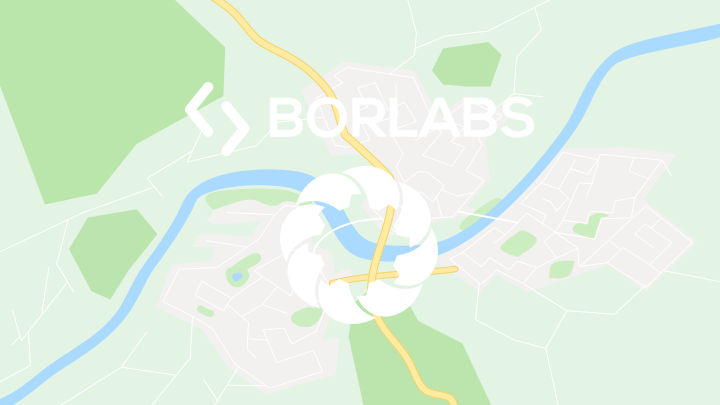
By loading the map, you accept Google’s privacy policy.
Learn more
Load map
Sultan Qaboos Mosque
Opened in 2009, the Sultan Qaboos Mosque in Salalah is one of the largest mosques in Oman and impresses with a mixture of traditional Omani architecture and modern design. Particularly striking are the 36-meter-high dome and the two imposing minarets, which give the mosque a majestic aura.
Inside, you will find a magnificent main hall with a huge carpet, ornate chandeliers, and detailed marble floors. The mosque can accommodate up to 3,200 worshippers – a truly impressive building!
- Address: On Nahdah Street, Salalah
- Opening hours: Saturday to Thursday from 8 a.m. to 11 a.m.
- Women’s clothing: short on top, long on the bottom + headscarf
- Men’s clothing: short on top, long on the bottom
- Entry: free
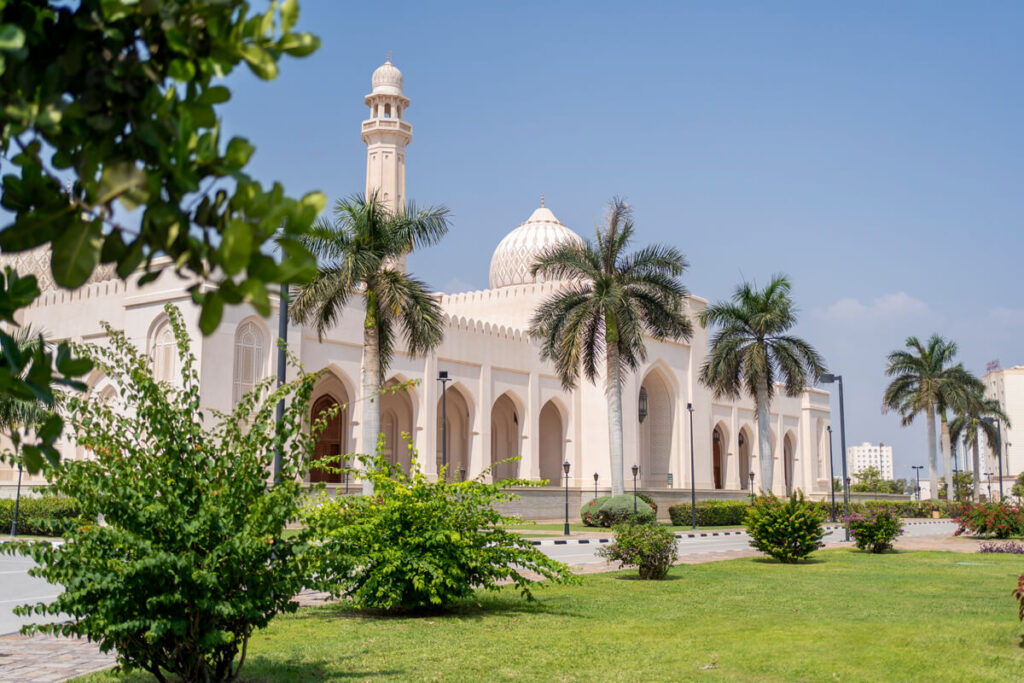
Al-Husn Souk
n Salalah you can visit the Al-Husn Souk, right in the Close to the beach, shop for great souvenirs. This traditional market offers everything from textiles, incense, and spices to perfumes, jewelry, daggers, and souvenirs—you’re sure to find something to suit your taste.
During the Khareef season, the souk is especially popular with Omanis and visitors from the Gulf. Between October and April, however, you will find many Europeans here.
- Address: 2422+PGQ, Salalah, Oman
- Opening hours: daily from 8 a.m. to 10 p.m. (many shops are closed at lunchtime)
- Admission: free
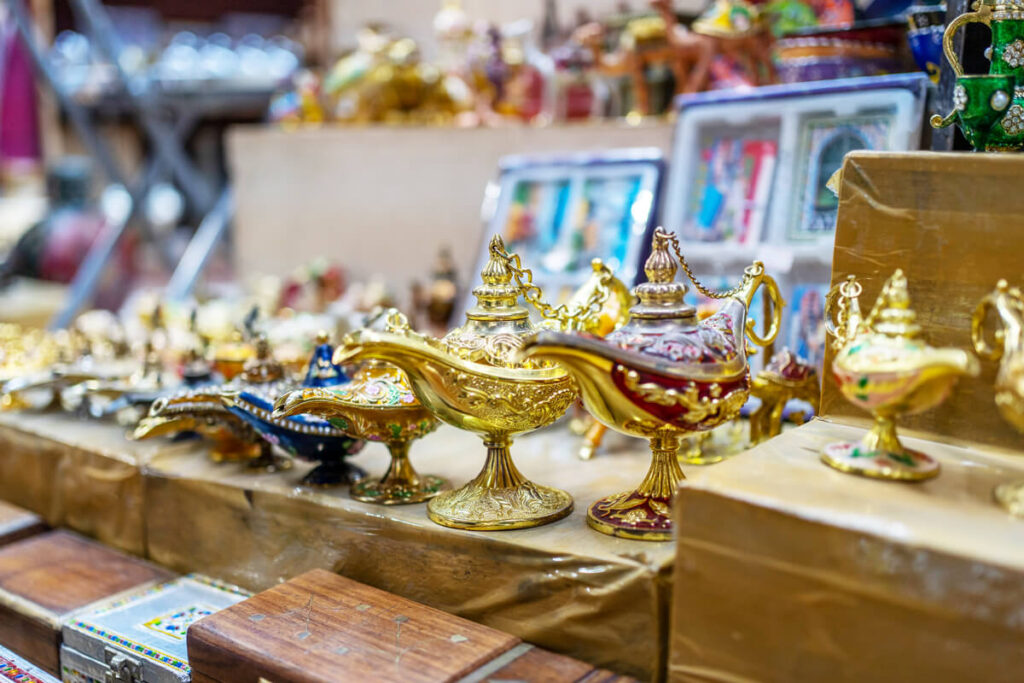
Frankincense Museum
The region around Salalah was once the center of the ancient frankincense trade and played an important role in the economy and culture. An exciting place to learn more about this is the Frankincense Museum.
This small museum displays exhibits that trace the history of the frankincense trade from ancient times to the present day. Here you can discover tools, artifacts, and historical documents that illustrate the process of frankincense extraction and processing.
- Address: As Sultan Qaboos Street, Salalah
- Opening hours: Sun. – Thurs. 9 am to 7 pm; Fri. & Sat. 3 p.m. to 7 p.m.
- Entrance fee: 2 rials per person
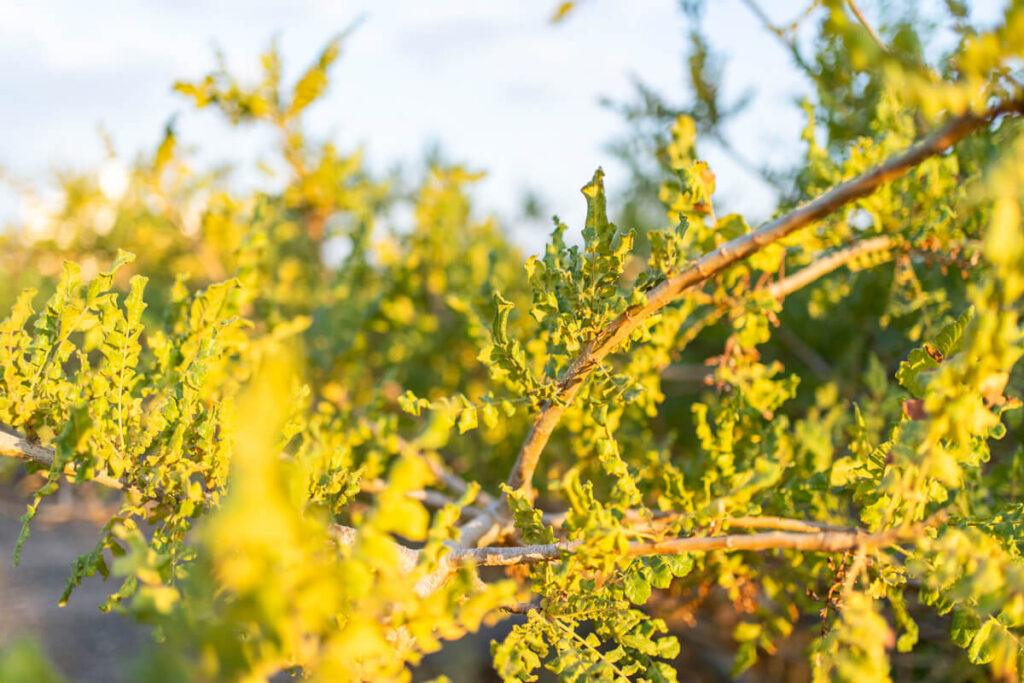
Beach promenade
The south of the country is blessed with stunningly beautiful, sometimes deserted beaches. One of the most beautiful beaches in Salalah in Oman is Al Haffa Beach, which boasts huge coconut palms and soft, light sand. And of course, not to forget the turquoise sea, which makes this view almost perfect.
Locals prefer to come to the beach shortly before sunset to end the day in a relaxed manner. Generally, this time of day is always the busiest time on the country’s beaches.

In Salalah, you can see many farms with coconut palms and banana trees. If you take a walk on the beach, sooner or later you will also discover the colorful wooden huts under the palm trees (As Sultan Qaboos Street). There you can buy fresh fruit (coconuts, bananas, papaya, etc.) at reasonable prices. Right next to the Souk Al-Hosn, a brand-new beach promenade with numerous shops, cafés, and restaurants is currently being built.
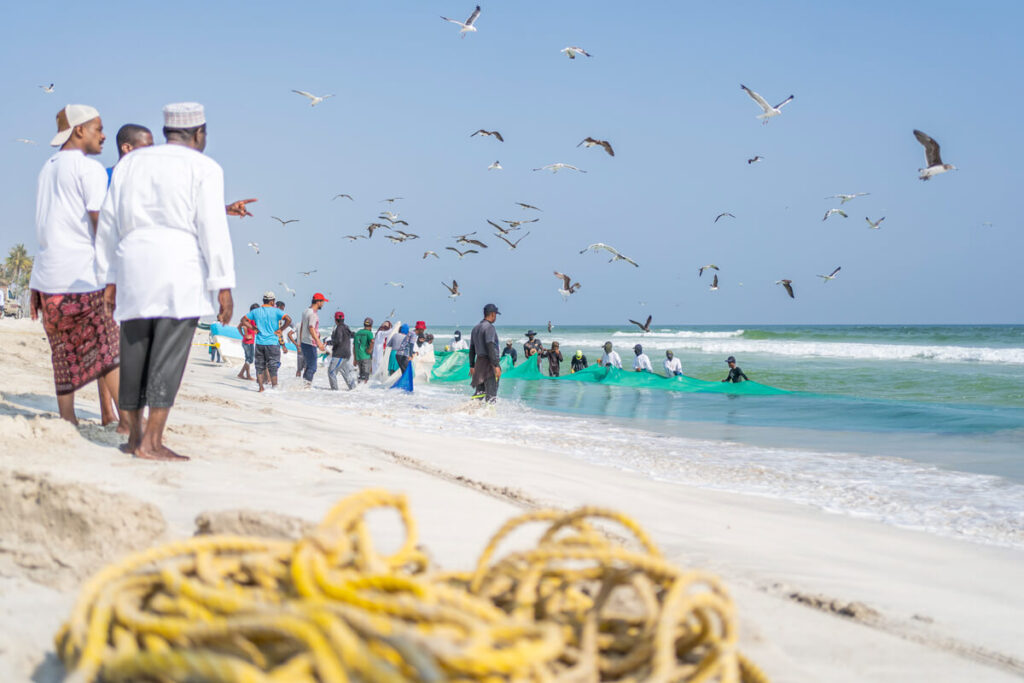
Hawana Salalah
Another very interesting area is the Hawana Salalah residential complex. It is a kind of international holiday oasis with top resorts and hotels, great apartments, an aqua park, a more than 8-kilometer-long beach, and spacious pool complexes.
This mega-project also includes a charming harbor promenade with shops, restaurants, and cafés. We rented a cool apartment in Hawana Salalah, from where we explored the diverse region.
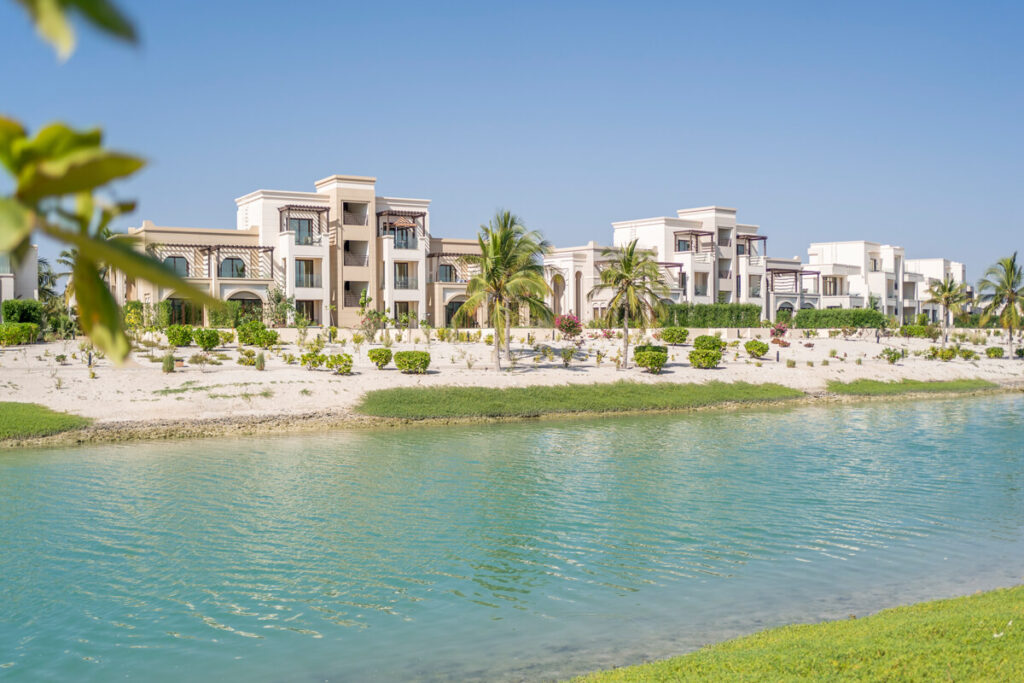
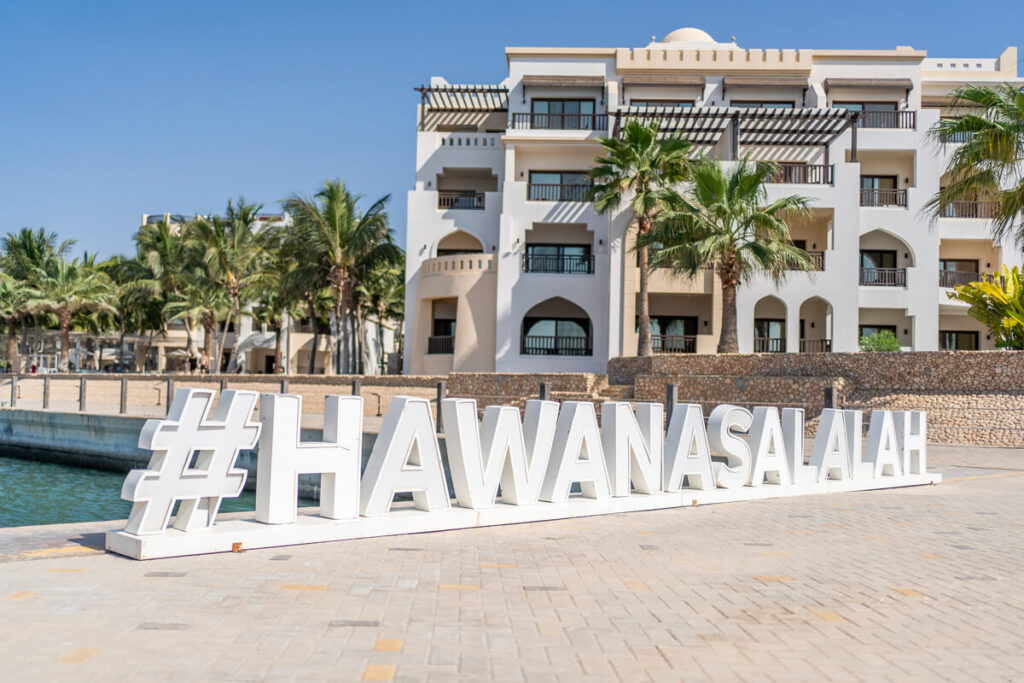
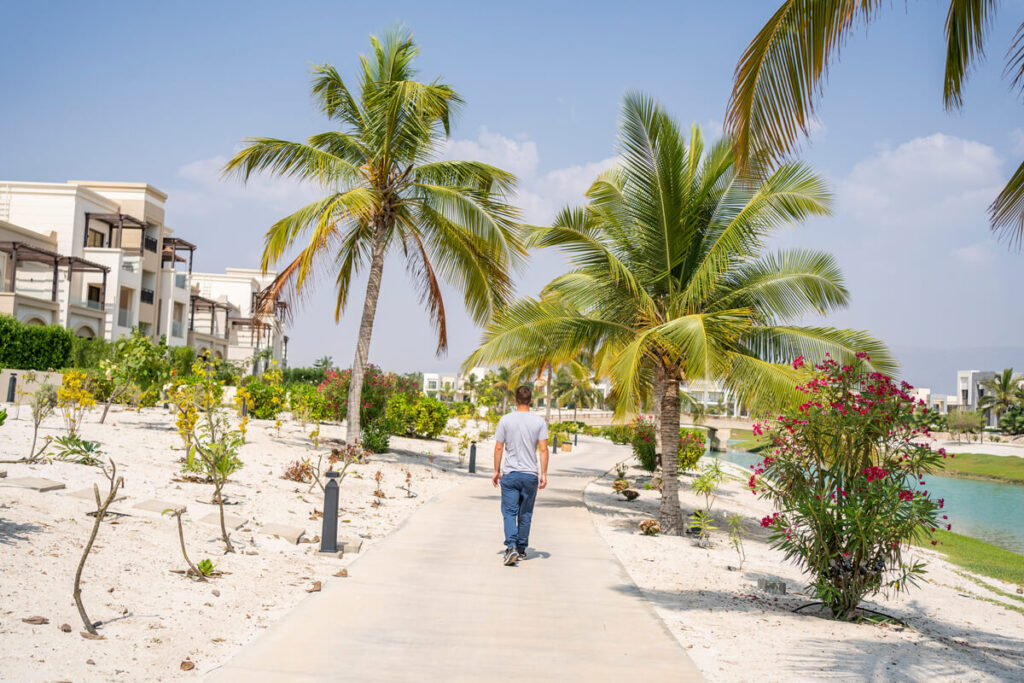
Excursion tips around Salalah
There is a lot to discover around Salalah in Oman. Whether it’s stunningly beautiful beaches, lush green wadis, impressive mountains or traditional fishing villages – in the following section we will show you a few cool highlights around Salalah. If you don’t feel like driving yourself in a rental car, you will also find some cool guided tours and excursions below.
- Salalah East Adventure: Waterfalls, Mountains & Safari*
- Salala: Highlights in the West – Half-Day Tour*
- City Tour: Nature, Culture, History, Food, Shopping*
- Underwater: Discover the Snorkeling Paradise of Mirbat*
- From Salalah: Desert Safari in the Empty Quarter – Rub Al Khali*
Wadi Darbat
The Wadi Darbat, only about 40 kilometers from Salalah, is one of the region’s most popular highlights. Especially during the Khareef season from June to September, the valley transforms into a green oasis with seasonal waterways and impressive vegetation.
After heavy rainfall, you can even experience waterfalls up to 200 meters high, spectacularly cascading down a mountain cliff. But even outside of the rainy season, Wadi Darbat is definitely worth a visit.
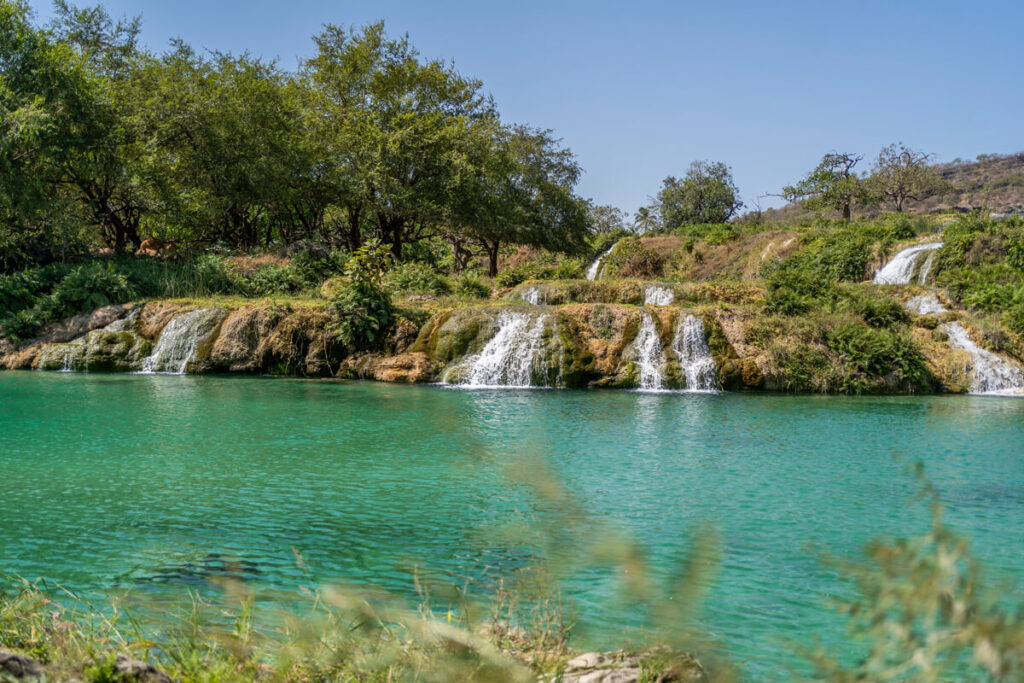
We visited in November and were greeted by a picturesque setting. We even saw some camels in the water. There are also picnic areas along the banks of Wadi Darbat, perfect for a break. During the Khareef season, you can also take boat trips on Lake Darbat or rent pedal boats (3 rials per 30 minutes).
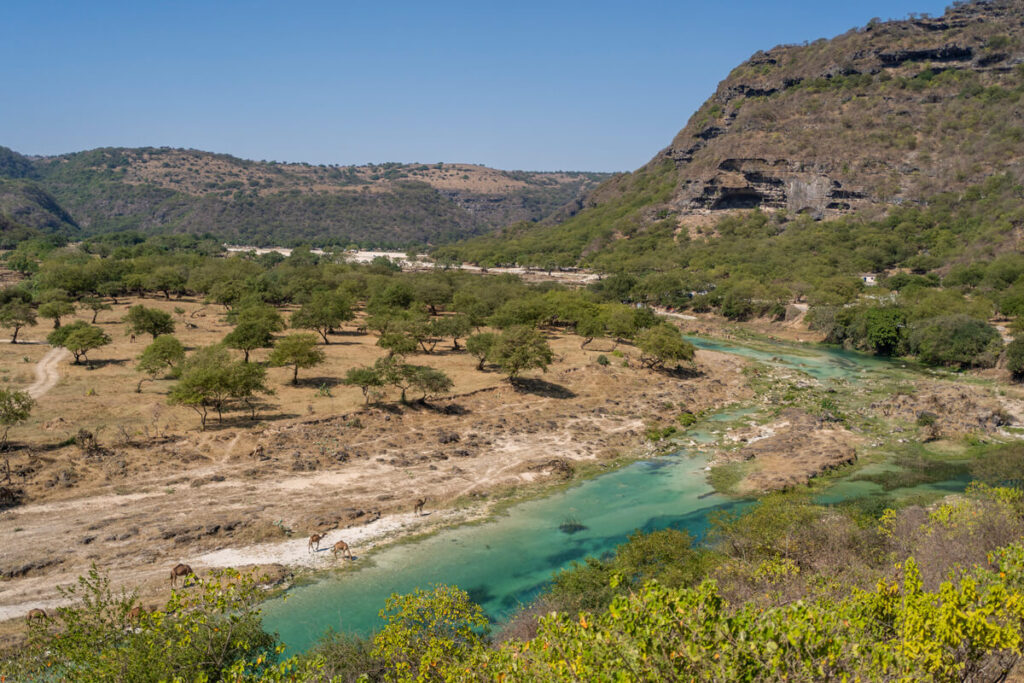
Twai Attair Sinkhole
Another attraction around Salalah is the Tawi Atair Sinkhole, a 100 m wide and 200 m deep sinkhole filled with groundwater. Translated, “Tawi Atair” means “well of the birds,” as the sinkhole is a popular haunt for migratory birds. Many bird species can be observed here, especially during the monsoon season. Along the viewing paths, you can marvel at the sinkhole and the steep rock faces.
Taqah
The tranquil town of Taqah is located just 30 minutes east of Salalah. However, Taqah is not as small as it appears at first glance. Dhofar’s third-largest city has a population of just under 21,000, yet it exudes a sleepy, cosy atmosphere.
Taqah is home to the almost 200-year-old Taqah Castle, which once served as the home of a former Wali. Just a few meters away, on a hill, is the Burj Al Askar defense tower, from which you have a fantastic view of the city and the sea.

Another highlight in Taqah is the Koofan Heritage House*, which is located directly opposite the palace. This unique building combines a museum, hotel, café, and souvenir shop under one roof.
The approximately 150-year-old traditional mud and stone house has been painstakingly restored by the owner’s family. We stayed there in one of the 12 individually decorated rooms, which was definitely one of the highlights of our entire trip.
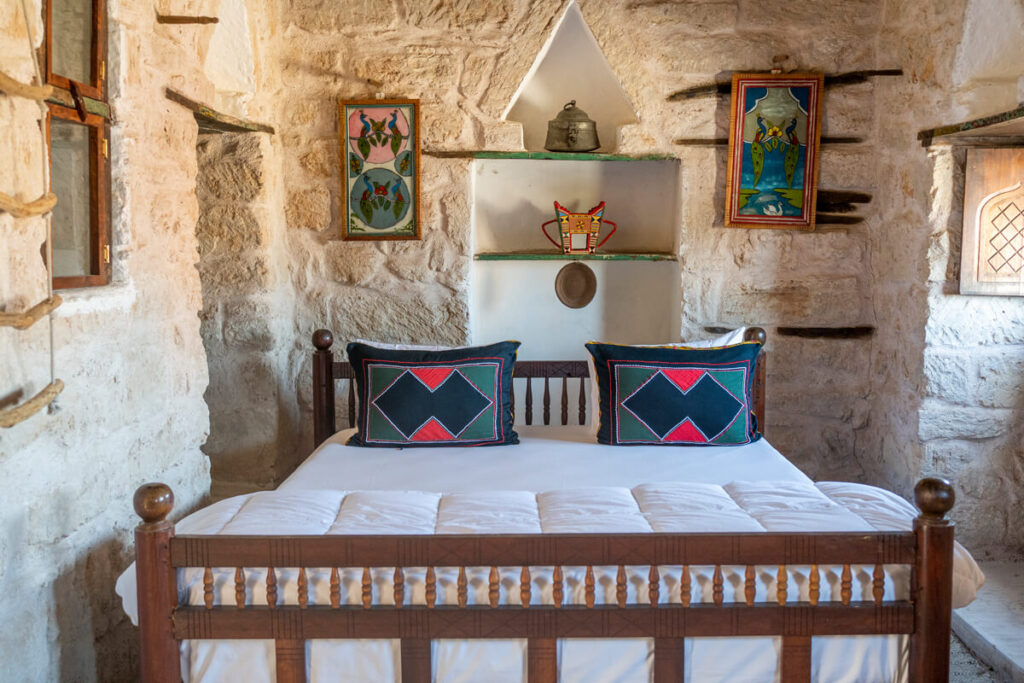
The kilometer-long sandy beach is overlooked by imposing cliffs on the eastern edge. From up there, you have a stunning view of the sea in the evening. We highly recommend admiring the sunset from the so-called “viewing rock.”
In the evening, many locals meet on the beaches to play soccer and go swimming. Often they just sit on mats and blankets to end the day comfortably.

Mughsail Beach & Marneef Cave
Mughsail Beach is located in the southwest of Salalah, about 40 kilometers from the city and just under 115 kilometers from the Yemeni border. The coastal landscape surrounding this expansive bay is impressive, with steep cliffs, golden sand, and the deep blue Arabian Sea. A few coconut palms adorn the approximately 6-kilometer-long beach, which you’ll usually have to yourself, especially during the week.
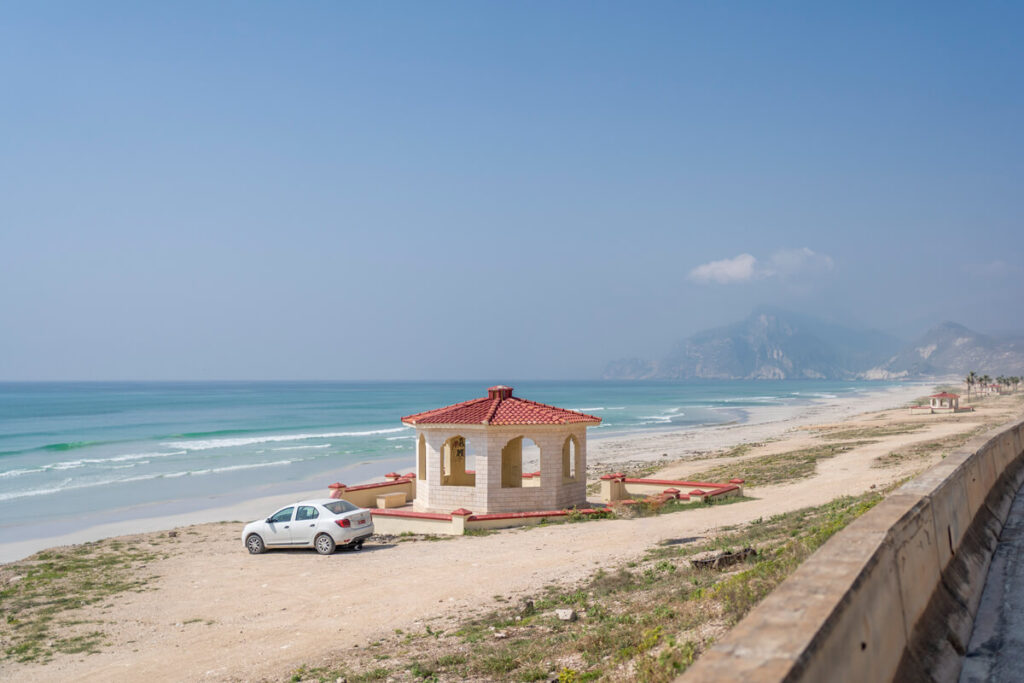
In the immediate vicinity of Mughsail Beach lies the Marneef Cave, a semi-cave formed from overhanging and heavily jagged rocks. From there, you have an impressive view of the sea. Continue following the paths to the “blowholes,” from which water is catapulted into the air during high swells and high tides.
During the monsoon season, these jets reach heights of 10 meters. You’ll also find great viewing platforms, picnic areas, and a snack bar with sea views.

Fazayah Beach
From Mughsail Beach, if you return to Road 47 and travel about 20 kilometers, you’ll reach the enchanting Fazayah Beach. The last 5 kilometers lead steeply downhill from the mountains, several hundred meters down an unpaved track, to the sea.
We recommend only driving this route with a four-wheel drive vehicle, as a conventional car may not have enough power for this route.
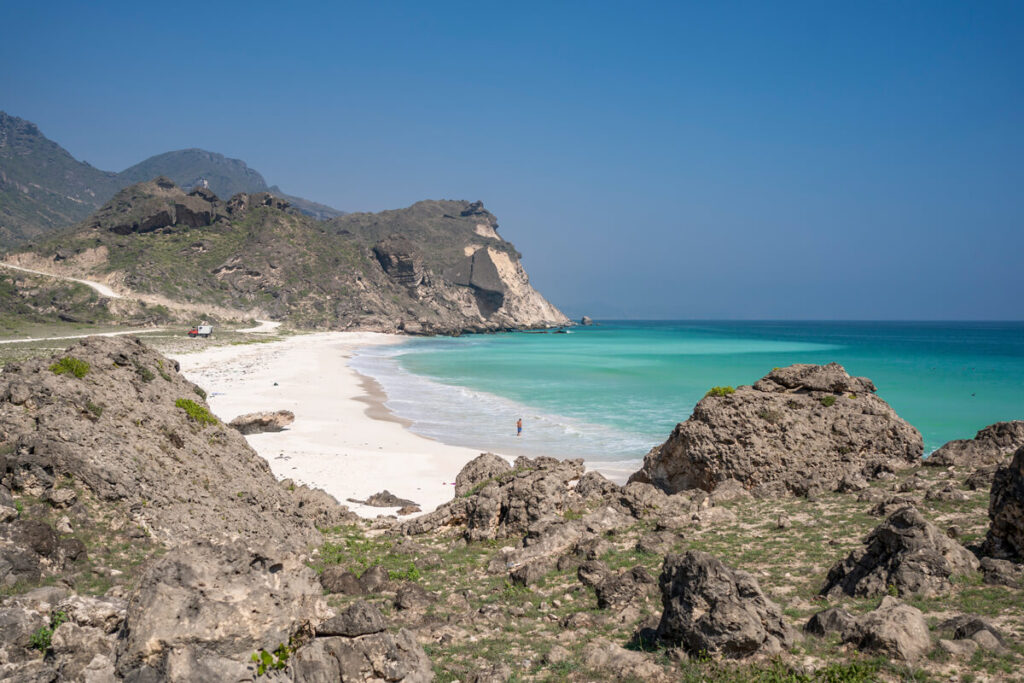
Once you reach the bottom, you can head to one of the bays and plunge into the sea. The beaches there are simply stunningly beautiful. We were also lucky enough to see turtles and dolphins in the area.
If you drive to the end of the track, you’ll reach a great viewpoint. There is no infrastructure on site. Therefore, bring enough snacks, drinks, sunscreen, and swimwear.
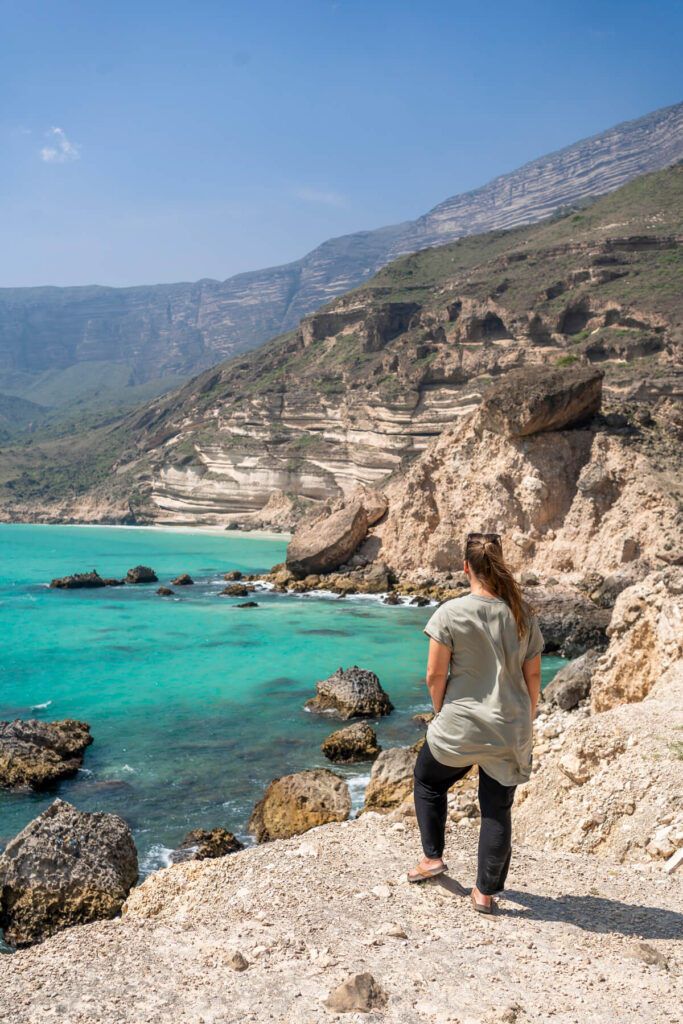
Other sights:
- Jebel al-Qamar (impressive drive between Mughsail and the border with Yemen)
- Impressive Jabel Samhan Viewpoint (1,300 m altitude)
- Ain Sahlounout spring
- Samhuram archaeological site (UNESCO World Heritage Site)
- Wadi Hinna with the famous baobab trees
- Salalah Anti Gravity Point/Magnetic Hill
Great Hotels & Resorts
Salalah offers a wide range of accommodation options to suit different needs and budgets. The city has several luxury hotels and resorts, often located on the beach or in scenic areas. These include the Al Baleed Resort Salalah by Anantara* and the Hilton Salalah Resort*, which offer exclusive service, high-quality accommodations, and a relaxed atmosphere.
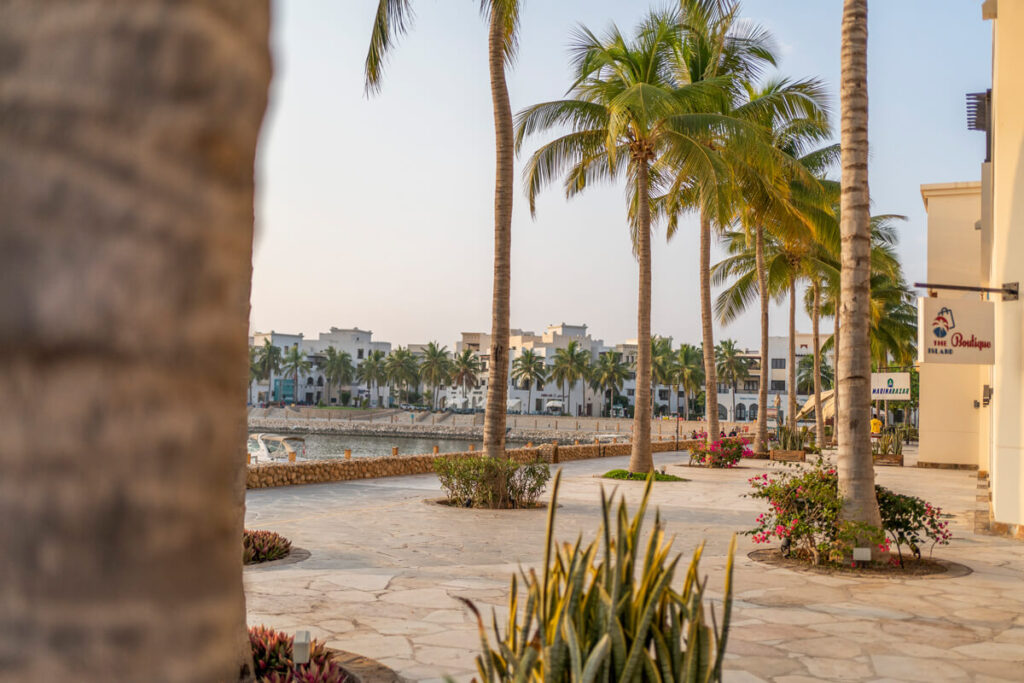
There are also many mid-range hotels that offer comfortable accommodations at affordable prices. The Crowne Plaza Salalah* is a popular choice in this category, offering a good location and modern amenities.
If you’re on a budget, you’ll also find numerous budget hotels and guesthouses in Salalah. The Hamdan Plaza Hotel* is one option that’s both affordable and centrally located.
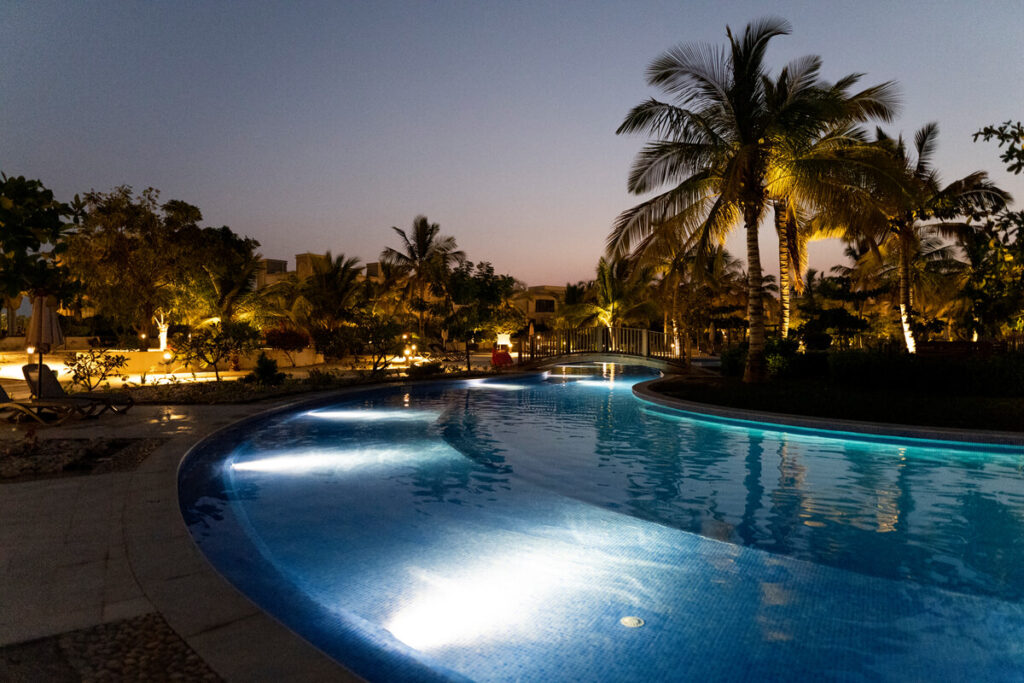
For travelers who prefer independence and flexibility, there are also many vacation rentals and self-catering accommodations available. This is a good option for longer stays or families.
For an authentic experience, consider traditional Omani accommodations such as guesthouses or bed and breakfasts. These often offer a great insight into local culture and hospitality.
- Salalah Rotana Resort*
- Salalah Fanar Hotel*
- Souly Ecolodge* (romantic beach bungalows)
- Alila Hinu Bay Salalah Mirbat*
Restaurant Tips & Cafés
Some great tips for restaurants and cafés will follow shortly…
How safe is a trip to Oman?
We can only repeat ourselves and assure you that a trip to Oman is very safe and you need not have any concerns. Security in Oman is exemplary, and crime is practically a foreign word here. No wonder Oman is one of the safest countries in the world.
The government has a pragmatic foreign policy and maintains good relations with various countries. Political unrest is generally not widespread. We have probably never felt as safe and welcome in a country as we did in Oman.
When is the best time to visit Salalah?
The best time to visit Salalah in Oman depends on your individual preferences and the activities you plan for your trip. Due to its unique monsoon climate, Salalah has two main seasons: the monsoon season and the dry season. It is, of course, most beautiful right after the monsoon, from late September to late October, when everything is still lush and green.
But even after that, it is a lot of fun to explore the region. We had 30 to 32°C every day, no clouds in the sky, and perfect temperatures for swimming. ☞ The best time to travel to Oman.
Monsoon Season (Khareef):
- Date: Usually from June to September (high season July & August)
During the monsoon season, known as Khareef, Salalah is transformed into a green oasis by drizzle and fog. Temperatures usually range between 29° and 32°C, and it is much more pleasant at higher altitudes. This time is perfect for holidaymakers from the Gulf states, while Europeans tend to avoid the humid and sticky conditions.
The monsoon season is ideal for birdwatching and photography, but attracts many tourists from neighboring countries in July and August. Important: You should book accommodation early, as the region is in high demand during this time.
Dry Season (Winter):
- Date: From October to May.
During the dry season, the climate is dry and temperatures are pleasantly warm. This is the peak travel time for most tourists, as the weather is ideal for outdoor activities, beach holidays, and sightseeing.
The dry season also offers opportunities to experience traditional festivals and events in Salalah. Most Europeans travel to the south of the country during this time. We had an average of 30°C every day, cloudless skies, and water temperatures around 26°C.
Do I need a rental car in Salalah?
If you want to explore Salalah on your own, we recommend renting a car. This gives you flexibility and allows you to explore the area as you wish. International and local car rental companies are available at the airport and in the city.
We recommend booking your rental car online in advance*. A mid-size car, for example, costs around €229 for a week in March. If you prefer an SUV, you should expect to pay around €465.
Important when booking a rental car:
- Comprehensive insurance and theft protection with no deductible
- Glass/tire protection, underbody protection
- Unlimited mileage
- Fuel policy full/full
- Good reviews of the provider
- Reasonable deposit
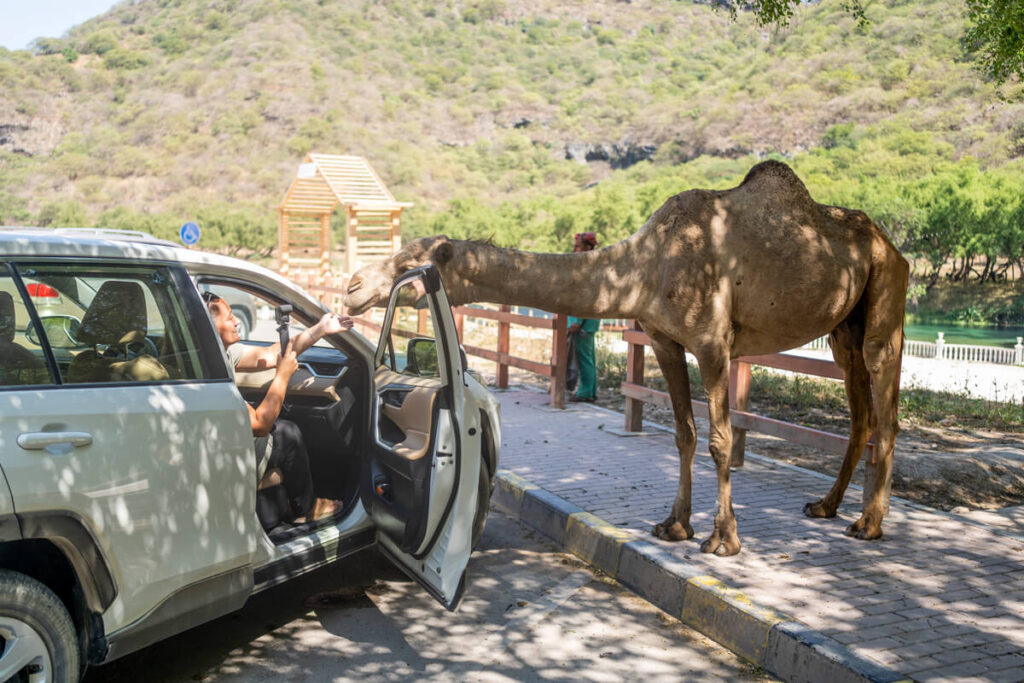
How do I get to Salalah in Oman?
Salalah International Airport (SLL) serves the region and is well connected to various international airports, such as Dubai, Abu Dhabi, Doha, and Munich. Direct and connecting flights are available. Flight times may vary depending on your departure airport. If you are already in Oman, you can fly to Salalah from Muscat, among others. Oman Air and SalamAir offer regular domestic flights for under €100. You can find a great overview of flight times and prices here: Book flights with Skyscanner*.
Salalah is also connected to other cities in Oman via a well-developed road network. A journey from Muscat to Salalah can take around 10 to 12 hours, depending on traffic and route. The roads are very well-developed and very safe. It took us around 10 hours to travel the almost 1,000 kilometers from Nizwa to Salalah.
There are long-distance buses that travel between various cities in Oman. These are an affordable option, but the journey to the south can take a very long time (14 to 16 hours). ONTC buses run daily from Muscat to Salalah (bus line 100). Departure times here. A one-way ticket costs only 8 rials, which is equivalent to just €19. List of bus routes in Oman.
Salalah in Oman – Our Conclusion
We are really glad that we made the long drive and explored the south of the country for 5 days. The beaches are stunningly beautiful and occasionally even reminded us of the Caribbean. We also thought it was cool that we saw so many wild dromedaries in the south of the country, sometimes on the side of the road, in the wadis, or on the beach.
Salalah in Oman offers a fantastic combination of lush nature, great beaches, good food, and interesting buildings. We only recommend the south of Oman to first-time visitors if you have enough time. Plan at least 7 to 10 days for the north of the country and at least 4 to 5 days for the south.